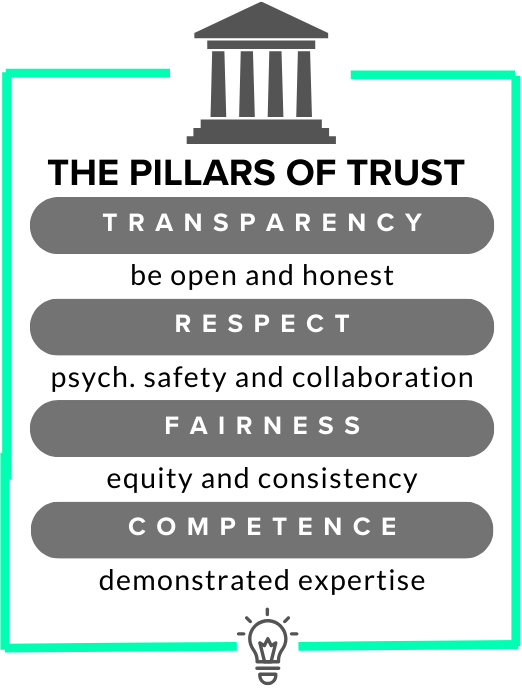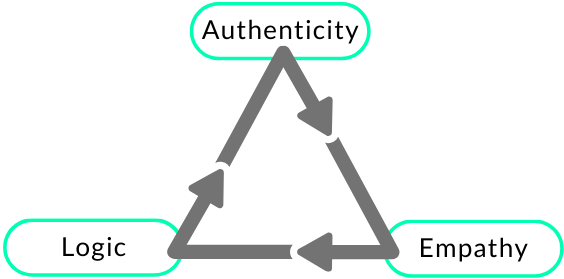Trust and the employee experience (EX)
and why it’s the cornerstone of a thriving workplace
Trust. It’s a simple word, but it carries immense weight in the workplace. The employee experience (EX) hinges on it, and when trust is broken it can have a ripple effect, damaging productivity, engagement, and even your organisations bottom line.
In this blog, we’ll delve into the significance of trust in EX, exmplore the pillars that uphold it, and provide actionable insights to cultivate a high-trust environment within your organisation.
The power of trust in the workplace
Trust isn't just a "nice to have." Research from Harvard Business Review reveals the tangible benefits enjoyed by employees in high-trust organisations:
-
Imagine a workforce that feels supported, valued, and secure. They're less likely to experience burnout and are better equipped to handle challenges.
-
When employees trust their leadership and colleagues, they collaborate more effectively, make decisions efficiently, and are more invested in achieving company goals.
-
High-trust environments foster a sense of ownership and pride in work. Employees are enthusiastic, motivated, and committed to their roles.
-
When trust is lacking, cynicism and exhaustion can quickly set in. A high-trust workplace promotes psychological safety and well-being.
The Pillars of Trust
Trust isn’t built on a single factor, but rather on a foundation of several key pillars:
Transparency: Be open and honest in your communication. Share information, acknowledge mistakes, and be upfront about challenges.
Respect: Foster a culture of psychological safety where everyone feels their opinions are valued and their contributions are recognised.
Fairness: Ensure that policies, practices, and decisions are equitable and consistently applied.
Competence: Demonstrate expertise in your field, make sound decisions, and fulfill your commitments.
Cracks in the Foundation: When Trust Crumbles
While the pillars of trust represent the ideal, the reality is that organisations often fall short. Here's a closer look at how trust can break down in each area:
Transparency:
Secretive decision-making: Employees are left in the dark about changes that directly impact them.
Lack of communication: Important information is withheld, leading to rumors and speculation.
Disingenuous messaging: Leadership says one thing but does another, eroding credibility.
Respect:
Bullying or harassment: Toxic behavior creates a hostile work environment.
Dismissing feedback: Employees feel their voices aren't heard or valued.
Favoritism: Special treatment for some creates resentment among others.
Fairness:
Inconsistent policies: Rules are applied differently to different employees, leading to feelings of injustice.
Unequal opportunities: Promotions or development opportunities are based on personal biases rather than merit.
Unfair compensation: Pay disparities create a sense of inequity.
Competence:
Poor decision-making: Leaders make choices that negatively impact the team or company.
Missed deadlines: Commitments aren't kept, leading to frustration and a lack of confidence.
Lack of skills: Employees feel unsupported and ill-equipped to succeed in their roles.
The Domino Effect
When trust breaks down in one area, it can quickly spread to others. For example, a lack of transparency can lead to suspicion, which in turn can fuel disrespectful behavior and undermine fairness. The result is a workplace where employees feel disengaged, demotivated, and ultimately, distrustful.
The Cost of Broken Trust
-
Decreased Productivity and Innovation
Increased Turnover and Recruitment Costs
Absenteeism and Presenteeism
Damaged Rputation and Brand Image
-
Inefficient Communication and Decision Making
Increased Conflict and Grievances
Low Morale and Engagement
Difficulty Attracting and Retaining Talent
Rebuilding and Strengthening Trust
Thankfully, trust can be rebuilt. It requires meaningful action and a commitment to change. The Trust Triangle (Frei 2020) provides a framework to identify where trust has broken down and guide your next steps.
The Trust Triangle
Authenticity: Lead with empathy, demonstrate integrity, and align your words with your actions.
Logic: Clearly explain your reasoning behind decisions, provide data to support your choices, and involve employees in problem-solving.
Empathy: Show understanding and compassion for your employees' perspectives, concerns, and needs.
(Frei, 2020)
Measuring Trust and Monitoring Progress
Regularly assess team sentiment through engagement surveys, focus groups and pulse checks. Review this feedback with the pillars of trust in mind and identify areas for improvement.
the ripple effect:
Trust as a catalyst for organisational success
Trust is contagious. When leaders and employees prioritise trust-building, its positive effects radiate throughout the organisation, creating a virtuous cycle of growth and success.
A Magnet for Top Talent:
High-trust workplaces are sought after by top performers who value a positive and supportive environment.
Employees are more likely to refer their talented friends and colleagues, reducing recruitment costs and ensuring a steady stream of qualified candidates.
Trust fosters loyalty, leading to higher retention rates and a more stable workforce.
A Breeding Ground for Innovation:
When employees feel safe to take risks, share ideas, and challenge the status quo, innovation thrives.
Trust encourages collaboration and knowledge sharing, leading to breakthrough solutions and a competitive edge.
A culture of trust fosters a willingness to experiment and learn from failures, accelerating the pace of innovation.
A Foundation for Exceptional Customer Experiences:
Employees who trust their leaders and colleagues are more likely to go above and beyond for customers.
A high-trust culture empowers employees to make decisions and take ownership of customer interactions.
Satisfied employees are more likely to provide exceptional service, leading to loyal customers and positive brand perception.
Enhanced Employee Well-Being and Engagement:
High-trust workplaces reduce stress and burnout, leading to a healthier and happier workforce.
Employees who feel valued and trusted are more engaged in their work, resulting in increased productivity and creativity.
A sense of belonging and camaraderie fosters a positive work environment that attracts and retains top talent.
Stronger Financial Performance:
All of these positive outcomes ultimately contribute to a stronger bottom line.
High-trust organisations enjoy increased productivity, reduced turnover, improved customer satisfaction, and a stronger brand reputation.
Investing in trust-building initiatives is not just a feel-good measure; it's a smart business strategy.
Beyond the Workplace: Trust in the Community
The ripple effect of trust extends beyond the walls of the organisation. High-trust companies are more likely to be seen as responsible corporate citizens, contributing to the well-being of their communities. This can lead to positive public relations, stronger partnerships, and increased brand loyalty.
The Ripple Effect in Action
Imagine a workplace where employees feel safe to speak their minds, where leaders are transparent and accountable, and where everyone is treated with respect and fairness. This is a workplace where trust is not just a buzzword, but a lived reality. And in this workplace, the ripple effect of trust creates a wave of positive change that benefits everyone involved.
Download the trust in EX Cheat Sheet
ABOUT NICK GEAREN
Casual and approachable, Nick is your go-to for all things HR with a twist of personality. He’s all about making work a little more enjoyable while driving results.
Nick’s HR journey has been quite the ride, even landing him a HRD rising stars award in 2022 for his innovative HR strategies
MBA Qualified, he’s all about empowering individuals and teams to excel.
Nick understands that HR can be a bit of a whirlwind, so he’s here to create an environment where everyone thrives. Through strategic moves, a culture of ongoing learning, and optimising HR processes he helps businesses adapt, grow and reach their goals.


